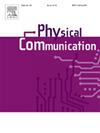A group-based coarse-fine algorithm for intelligent reflecting surface beamforming
IF 2
4区 计算机科学
Q3 ENGINEERING, ELECTRICAL & ELECTRONIC
引用次数: 0
Abstract
In the optimization problem of an intelligent reflecting surface (IRS) -assisted or -aided wireless communication system, which is usually a non-convex combinatorial single-objective/multi-objective non-deterministic polynomial hard problem, both the non-binary parameters of the system model and binary weights of the IRS elements are found to maximize the objective function. In this paper, we convert the original optimization problem into two problems. The primary problem is finding the desired IRS array factor without focusing on the binary weights. The secondary one is finding the binary weights of the IRS elements to reach the desired array factor with minimum error. We model and solve the secondary problem using an algorithm to activate/deactivate elements of the IRS. First, the proposed algorithm generates random matrices consisting of 0/1 weights, which create array factors with a tolerable error, and selects the matrix with minimum error. Second, it changes the weights of the matrix one by one up to the second predefined iteration number and saves it if the error is reduced. For 36 elements with 0.5 wavelength inter-element spacing, a tolerable amount of error of 0.1, and 1000 iterations, all-on, improved all-on, constrained random on-off, improved constrained random on-off, and Genetic solutions show 25%, 21%, 11%, 5%, and 7% error, respectively. In addition to the computational complexity, the complexity order of the proposed algorithm is derived and compared with both exhaustive search and the Genetic algorithm. Furthermore, the precision, processing time, and the difference between the obtained and desired weights are compared in 2 × 2-dimension to 10 × 10-dimension configurations.

基于群的智能反射面波束形成粗精算法
智能反射面(IRS)辅助或辅助无线通信系统的优化问题通常是一个非凸组合单目标/多目标非确定性多项式难题,其目的是寻找系统模型的非二元参数和IRS元素的二元权重以使目标函数最大化。本文将原优化问题转化为两个问题。主要问题是找到所需的IRS阵列因子,而不关注二进制权重。第二步是求出IRS元素的二值权值,以使误差最小的情况下得到期望的数组因子。我们使用一种激活/停用IRS元素的算法来建模和解决次要问题。首先,该算法生成0/1权重的随机矩阵,生成误差可容忍的数组因子,并选择误差最小的矩阵。其次,它逐个改变矩阵的权重,直到第二个预定义的迭代次数,如果误差减少,则保存它。对于波长间隔为0.5的36个元素,可容忍的误差为0.1,迭代1000次,全开、改进全开、约束随机开-关、改进约束随机开-关和遗传解分别显示25%、21%、11%、5%和7%的误差。除了计算复杂度外,还推导了该算法的复杂度排序,并与穷举搜索和遗传算法进行了比较。此外,还比较了2 × 2维和10 × 10维配置下的精度、处理时间以及获得的权重和期望权重之间的差异。
本文章由计算机程序翻译,如有差异,请以英文原文为准。
求助全文
约1分钟内获得全文
求助全文
来源期刊

Physical Communication
ENGINEERING, ELECTRICAL & ELECTRONICTELECO-TELECOMMUNICATIONS
CiteScore
5.00
自引率
9.10%
发文量
212
审稿时长
55 days
期刊介绍:
PHYCOM: Physical Communication is an international and archival journal providing complete coverage of all topics of interest to those involved in all aspects of physical layer communications. Theoretical research contributions presenting new techniques, concepts or analyses, applied contributions reporting on experiences and experiments, and tutorials are published.
Topics of interest include but are not limited to:
Physical layer issues of Wireless Local Area Networks, WiMAX, Wireless Mesh Networks, Sensor and Ad Hoc Networks, PCS Systems; Radio access protocols and algorithms for the physical layer; Spread Spectrum Communications; Channel Modeling; Detection and Estimation; Modulation and Coding; Multiplexing and Carrier Techniques; Broadband Wireless Communications; Wireless Personal Communications; Multi-user Detection; Signal Separation and Interference rejection: Multimedia Communications over Wireless; DSP Applications to Wireless Systems; Experimental and Prototype Results; Multiple Access Techniques; Space-time Processing; Synchronization Techniques; Error Control Techniques; Cryptography; Software Radios; Tracking; Resource Allocation and Inference Management; Multi-rate and Multi-carrier Communications; Cross layer Design and Optimization; Propagation and Channel Characterization; OFDM Systems; MIMO Systems; Ultra-Wideband Communications; Cognitive Radio System Architectures; Platforms and Hardware Implementations for the Support of Cognitive, Radio Systems; Cognitive Radio Resource Management and Dynamic Spectrum Sharing.
 求助内容:
求助内容: 应助结果提醒方式:
应助结果提醒方式:


